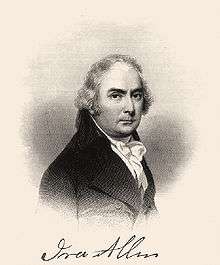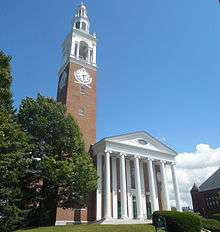Ira Allen
Ira Allen (April 21, 1751 in – January 7, 1814) was one of the founders of the U.S. state of Vermont and a leader of the Green Mountain Boys during the American colonial period. He was the younger brother of Ethan Allen.
Ira Allen | |
|---|---|
 Engraving of Ira Allen, c. 1810 | |
| Born | April 21, 1751 |
| Died | January 7, 1814 (aged 62) Philadelphia, Pennsylvania, United States |
| Nationality | American |
| Occupation | Surveyor, politician, military officer |
| Relatives | Ethan Allen (brother) |
Biography
.svg.png)
Ira Allen was born in Cornwall in the Connecticut Colony (in present-day Litchfield County, Connecticut), the youngest of six sons born to Joseph and Mary Baker Allen. In 1771, Allen went to Vermont (then part of the British colonial Province of New York) with his brother Ethan as a surveyor for the Onion River Land Company. The Allen brothers established the company in order to purchase lands under the New Hampshire Grants. Through this, Ira Allen became involved in a dispute with the Province of New York over conflicting land claims in the region.[1]
During the American Revolutionary War, Allen was a leading figure in the declaration of the Vermont Republic in 1777, which was originally intended to be independent of both the British colonies and the newly founded United States. Late in the war, he and his brother Ethan, along with Thomas Chittenden and others, were involved in the Haldimand Affair by their discussions with Frederick Haldimand, the British Governor of the Province of Quebec, about the possibility of reinstating Vermont as a British province. An alternate explanation is that the Allen brothers were not actually interested in returning Vermont to the British but merely used the Haldimand negotiations to both stave off a British invasion of Vermont from Canada and prod the Continental Congress into recognizing Vermont as separate from New York and New Hampshire and admitting it to the United States. Vermont was granted statehood in 1791.
Allen designed the Great Seal of Vermont. Over two days at Windsor in 1778, Allen drew the seal and Reuben Dean, a local silversmith, made it. The two men were each paid ten shillings for their work.[2]

In 1780, Allen presented to the state legislature a memorial for the establishment of the University of Vermont.[3] He contributed money and a fifty-acre (20 ha) site at Burlington. He was called the "Metternich of Vermont" and the "Father of the University of Vermont".[4] Ira Allen pledged 4,000 British pounds sterling to the University of Vermont, but never donated the money. In response, the Trustees of the University of Vermont secured a Writ of Attachment on his title to the town of Plainfield to try to extract payment of his original 4,000-pound pledge.[5]
Allen was Vermont's first Treasurer and held office from 1778 to 1786, when he was succeeded by Samuel Mattocks.[6] He also served as the first Surveyor General of Vermont from 1779 to 1787.[7][8] In 1789, Allen married Jerusha Enos, the daughter of Roger Enos and Jerusha Hayden Enos. Members of the Allen and Enos families were the original proprietors of Irasburg, Vermont, which was named after Ira Allen. Allen subsequently acquired all the proprietary rights to Irasburg and deeded the town to Jerusha Enos as a wedding gift.[9][10][11] Allen also owned undeveloped land, including a stake in Barton, Vermont.

On October 25, 1790, Ira Allen was commissioned Major General of the Third Division of the Vermont State Militia by Governor Thomas Chittenden.[12] He went to France in 1795 and sought French army intervention for seizing Canada in order to create an independent republic called United Columbia.[13] He bought 20,000 muskets and 24 cannons but was captured at sea, taken to England, placed on trial, and charged with furnishing arms for Irish rebels.[14] He was acquitted after a lawsuit which lasted eight years.[15]
Allen died in Philadelphia, where he had gone to escape imprisonment for debt. He was originally buried in Philadelphia's Arch Street Presbyterian Cemetery, but his remains were lost when that site was destroyed. There is a cenotaph in his memory at Wetherills Cemetery in Audubon, Pennsylvania, and another at Greenmount Cemetery in Burlington, Vermont. The Ira Allen Chapel on the University of Vermont's main campus was also named after him.[16][17]
Vermont Sesquicentennial half dollar
The obverse of the 1927 Vermont Sesquicentennial half dollar, designed by Charles Keck, depicts Allen above the words "Founder of Vermont".
Works

Allen published several books, including:
- The Natural and Political History of Vermont. London: J.W. Myers. 1798. ISBN 0-8048-0419-2.
- Statements Appended to the Olive Branch (1807)
References
- "Ira Allen (1751–1814)". Virtual Vermont. 2010. Retrieved 2010-03-09.
- "Dean, Reuben" in The Vermont Encyclopedia (eds. John J. Duffy, Samuel B. Hand & Ralph H. Orth: University of Vermont Press, 2003), p. 103.
- A.J.H Dyer (1896). "General Ira Allan". The American Monthly Magazine, Daughters of the American Revolution. R.R. Bowker Co.: 61.
- John Howard Brown (1900). Lamb's biographical dictionary of the United States. James H. Lamb Co. pp. 66–67.
- Graffagino, J. Kevin (1991). "A Hard Founding Father to Love". In Daniels, Robert (ed.). The University of Vermont, The First Two Hundred Years. Hanover, NH: University of Vermont, distributed by University Press of New England. ISBN 0874515491.
- Vermont Secretary of State, Legislative Directory, 1981, page 105
- William W. Stickney (1901). "Farewell address of William W. Stickney" (PDF). Vermont Journal of the Joint Assembly. Montpelier, VT: Vermont State Archives and Records Administration: 14. Archived from the original (PDF) on 2008-10-28.
- Vermont Historical Society Collections. Montpelier: Vermont Historical Society. 1871. p. 427.
- Vermont Development Commission, Vermont Life magazine, Volumes 41–42, 1986, page 45
- Hamilton Child, Gazetteer and Business Directory of Lamoille and Orleans Counties, Vt., 1883, page 288
- Ethan Allen, Ethan Allen and His Kin: Correspondence, 1772–1819, Volume 1, 1998, page 334
- LiveAuctioneers (October 25, 1790). "Ira Allen's Military Commission As Major General (Lot 4 of the Early American History Auction)" (jpg). LiveAuctioneers. Retrieved 2016-02-20.
- Robert E. May (2002). Manifest Destiny's Underworld: Filibustering in Antebellum America. U. of North Carolina Press. ISBN 0-8078-2703-7. Archived from the original on 9 February 2009. Retrieved 23 July 2008. Chapter 1
- Benson John Lossing (1851). The pictorial field-book of the revolution. Harper & Bros. p. 161. ISBN 0-87152-056-7.
- Ethan Allen Hitchcock, William Augustus Croffut (1909). Fifty years in camp and field: diary of Major-General Ethan Allen Hitchcock, U.S.A. G.P. Putnam's Sons. p. 31.
- "The Development of UVM's Vermontiana Collection" (PDF). Liber: A Newsletter for the Friends of Special Collections at UVM, Vol. III, No. 12. Spring 1987.
- Prevolos, Christine (2011). "University Green Area Heritage Study - Ira Allen Chapel (Historic Burlington Research Project - HP 206)". Burlington, Vermont: UVM Historic Preservation Program. Retrieved February 20, 2016.
External links
- Vermont Historical Society Collections. I. Montpelier: Vermont Historical Society. 1870.
- Vermont Historical Society Collections. II. Montpelier: Vermont Historical Society. 1871.
- Inventory of the Allen Family Papers, Special Collections, University of Vermont Library